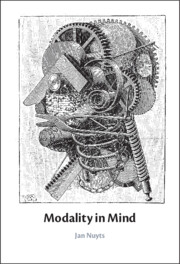Book contents
- Modality in Mind
- Modality in Mind
- Copyright page
- Contents
- Figures
- Tables
- Preface
- 0 Introduction
- 1 The Cognitive-Functional Approach
- 2 Qualifying States of Affairs
- 3 Modality Revisited
- 4 Attitudes
- 5 Beyond the Qualificational Hierarchy
- 6 (Inter)subjectivity, and More
- 7 Back to the Cognitive-Functional Approach
- 8 Conclusion
- References
- Person Index
- Subject Index
0 - Introduction
Published online by Cambridge University Press: 25 March 2025
- Modality in Mind
- Modality in Mind
- Copyright page
- Contents
- Figures
- Tables
- Preface
- 0 Introduction
- 1 The Cognitive-Functional Approach
- 2 Qualifying States of Affairs
- 3 Modality Revisited
- 4 Attitudes
- 5 Beyond the Qualificational Hierarchy
- 6 (Inter)subjectivity, and More
- 7 Back to the Cognitive-Functional Approach
- 8 Conclusion
- References
- Person Index
- Subject Index
Summary
The title of this book is deliberately ambiguous. Shared by both readings is the notion of modality, referring to a prominent semantic concept in the study of language use. The ambiguity resides in the alternation between a general and a more specific reading of the title. In the general reading, the title indicates that the notion of modality is used as a source of inspiration for exploring wider perspectives. In the more specific reading, the title suggests a concern with the position of modality in the human mind. Both readings apply to this book, and the specific reading refers to just one, albeit crucial, element of the wider perspectives implied in the general reading.
Information
- Type
- Chapter
- Information
- Modality in Mind , pp. 1 - 6Publisher: Cambridge University PressPrint publication year: 2025
